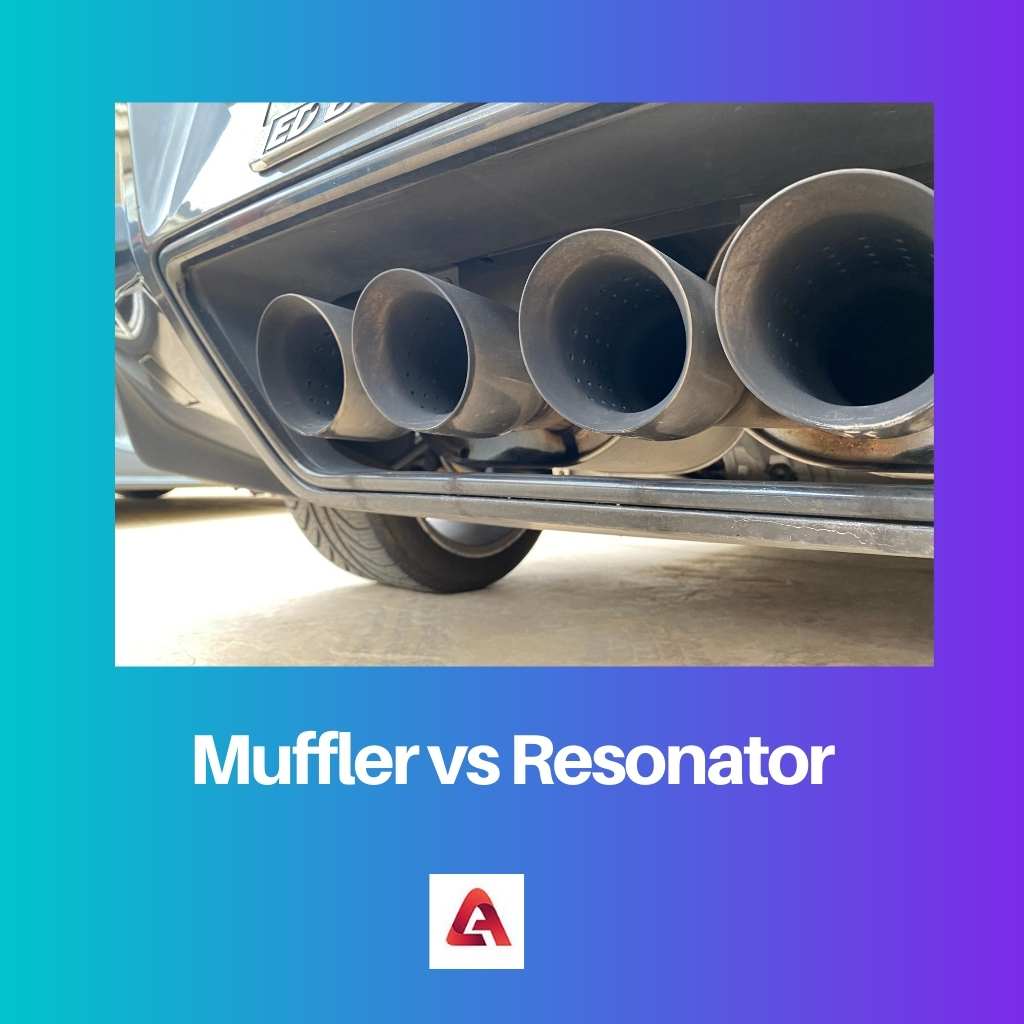Muffler and resonator are two kinds of devices present in the exhaust system of vehicles. The muffler and resonator have distinct purposes in the vehicles.
But both of the devices are combined and work together in the vehicle. Both the devices are important in the exhaust system to reduce emissions and sounds produced by the engines.
Key Takeaways
- Mufflers are exhaust system components that reduce engine noise, while resonators enhance the exhaust tone and decrease noise.
- Mufflers absorb and dissipate sound waves through a series of chambers and baffles, whereas resonators use a tuned pipe to cancel out specific sound frequencies.
- Installing a resonator in addition to a muffler can result in a quieter, more refined exhaust note and improved performance.
Muffler vs Resonator
Muffler is a device which is used to decrease the level of sound of an engine. Another name of muffler is silencer. There are five types of muffler. Resonator is a device used to modify frequencies. Another name of resonator is oscillator. There are two types of resonators. A resonator is embedded in an exhaust system.

Mufflers are a part of your vehicle exhaust system. The muffler is located at the bottom of the vehicle at the rear position. The muffler’s primary purpose is to reduce engine noise and dampen vehicle emissions.
The mufflers are manufactured of steel, and the outer part is coated with aluminum. The aluminum protects the mufflers from heat and chemicals.
The exhaust system releases more heat and chemicals which are handled by the mufflers. The engine pistons and valves create a loud sound while driving. These sounds are dissipated by the mufflers.
A resonator is a device present as a part of an exhaust system. The resonator is a system that exhibits resonance behavior. The resonator oscillates with high amplitude to produce greater frequencies called resonance frequencies.
The oscillations produced by the resonator may be electromagnetic or mechanical. The oscillations from the resonator also include acoustic. The primary use of the resonator is to select specific frequencies or generate particular frequencies.
Comparison Table
| Parameters of comparison | Muffler | Resonator |
|---|---|---|
| Other names | The muffler also called a silencer | Resonator also called an oscillator |
| Function | Exhaust gas from internal combustion | Exhibit resonance |
| Founded by | Milton Othello Reeves | Hermann von Helmholtz |
| Types | Five | Two |
| The introduced year | 1897 | 1967 |
What is a Muffler?
Mufflers are problem-handling device that is part of the exhaust system. The body of the mufflers ate made of steel to withstand extreme conditions. When the exhaust valve opens, a large amount of gas is released from the valve. Some powerful soundwaves are produced with the emissions.
You need to understand the creation of sound to know about the handling technique of sound by mufflers. Sound is nothing but high pressure due to vibrations. In simple, the muffler dissipates the sound waves into smaller forms.
The muffler works with sounds. The sounds are due to alternating pulses in pressures. A high pressured gas enters the exhaust system whenever it opens. Sound waves are produced when the high-pressure molecules collide with ow pressure molecules. These waves travel through the exhaust system and create sounds.
If pressure with the same properties as the pressure inside is pulled in then the sounds can cancel each other and pull out. The above process is happening inside the muffler and the process is called destructive interference.
The muffler has a simple design and is easy to precise. The tubes which have perforations can direct sound waves inside the mufflers.
The sound waves need to pass many chambers before entering the central chamber. Some sound waves enter the central chamber, and the remaining are passed to the resonator chamber.
The muffler is designed to cancel the noise anyways. The waves can bounce off and cancel each other.

What is Resonator?
The primary function of a resonator is to generate waves with specific frequencies. The acoustic resonators are used in musical instruments which produce sound waves in specific tones. Quartz crystals used in an electronic device are good examples of resonator.
They produce oscillations with precise frequency in quartz watches. The cavity resonator is a type of resonator that produces waves in the hollow space of the devices. Electronics devices like radio and microwaves use cavity resonators.
A cavity with one opening and air vibrating is produced in that cavity is called Helmholtz resonators. The resonators are used for different purposes.
The primary purpose of the resonator is to prepare loud noise coming from the engines. The resonator never eliminates the sounds, but it can change the sound waves. If a newly designed vehicle can be handover to the acoustic engineers to make the sound that comes from the engine must be pleasant as possible.
The resonators have a unique purpose in the exhaust system. Unlike mufflers, the resonator cannot reduce the volume of the sound. The resonator changes the sound waves.
To create a pleasant experience, the resonator works with a muffler and gives a pleasant experience while driving.

Main Differences Between Muffler and Resonator
- When compared to mufflers, resonators have low backpressure.
- Mufflers lower the sound level, whereas resonators deliver a sound level equivalent to a straight pipe.
- Mufflers do not stop buzzing, whereas resonators cancel frequencies to eliminate noises.
- When compared to mufflers, resonators are not designed with a bit of baffling.
- Mufflers work to reroute exhaust gases, whereas resonators do not reroute the gas.

